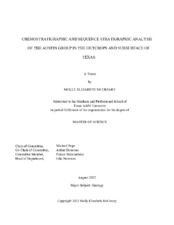| dc.description.abstract | The Austin Group, comprised of chalk and marly chalk, is a classic fractured chalk play, that has seen a renaissance as an unconventional reservoir exploited by the combination of fracking and horizontal drilling across Texas. At first glance, the Austin Group in outcrop, as well as in core, often appears as a vertically monotonous, homogenous succession of skeletal wackestones (chalk) alternating with argillaceous-prone mudstone beds. Detailed petrophysical, x- ray fluorescence (XRF) hemostratigraphic, and sequence stratigraphic analysis of the Austin Group in cores and outcrops across Texas, however, reveals a vertical succession of three chemostratigraphically-distinct, unconformity-bounded, chronostratigraphic units, which are defined and mapped in this study as the
Lower, Middle, and Upper Austin Formations.
The Latest Turonian to Late Coniacian Lower Austin Formation is a carbonate-rich, clay-poor depositional sequence that was deposited unconformably above the Eagle Ford Group. The Latest Coniacian to Middle Santonian Middle Austin Formation is a more argillaceous-rich depositional sequence, containing increased amounts of aluminum, silica, and titanium. The Middle Santonian to Middle Campanian Upper Austin Formation is the most carbonate-poor and terrigenous-rich depositional sequence within the Austin Group, and a regional unconformity separates it from the overlying Taylor Group.
The carbonate-rich Lower Austin Formation is the primary unconventional reservoir target of the Fractured Austin Chalk play across Texas. A detailed study of this lower unit was conducted in outcrop exposures along U.S. Highway 90 in Val Verde County, Texas. The Lower Austin Formation also was analyzed in several industry and United States Geological Survey (USGS) research boreholes across Texas. Analysis of this core data indicates that the Lower Austin Formation systematically becomes more terrigenous/argillaceous-rich northward towards Dallas. This facies change is interpreted to record more proximal depositional environments within the Lower Austin Formation. | |


